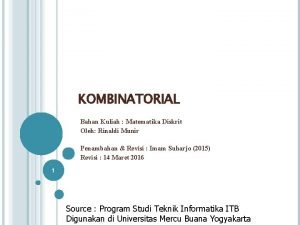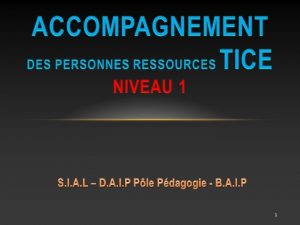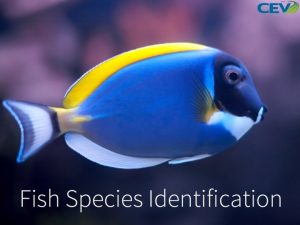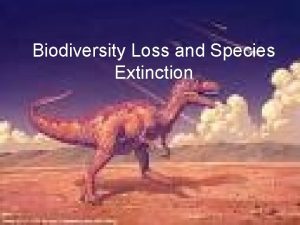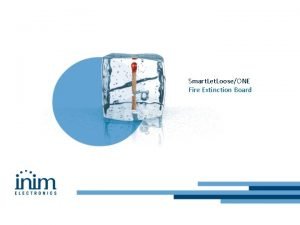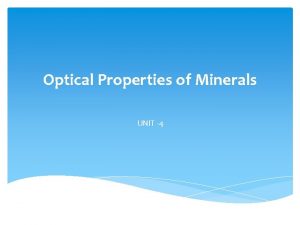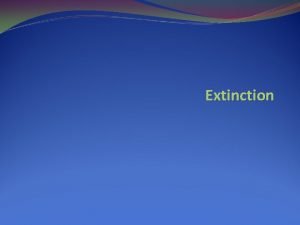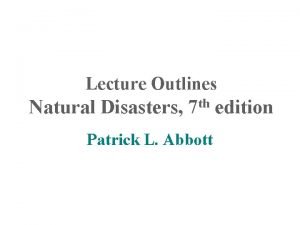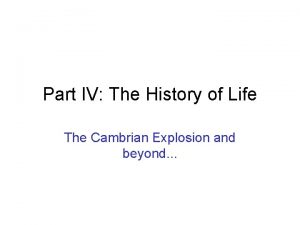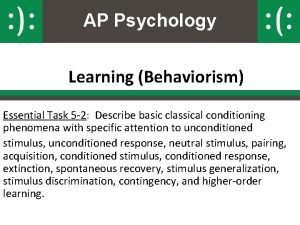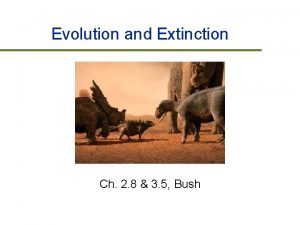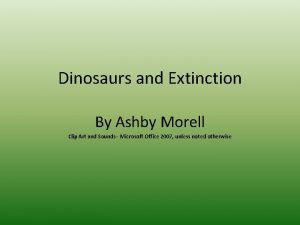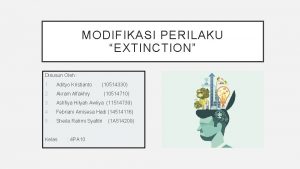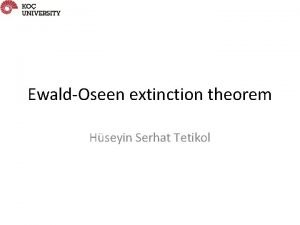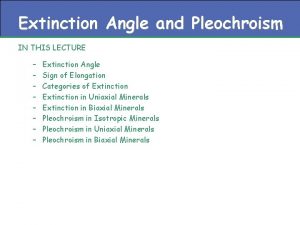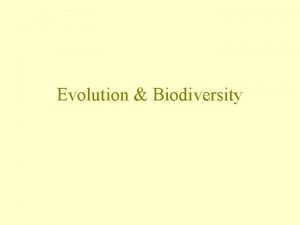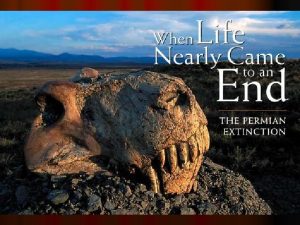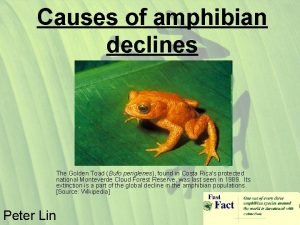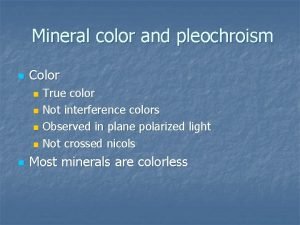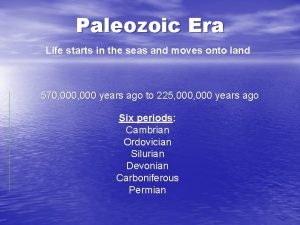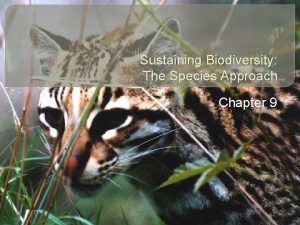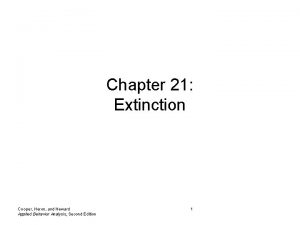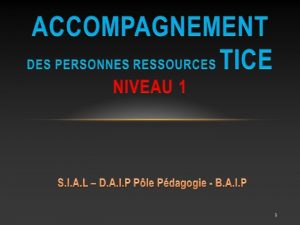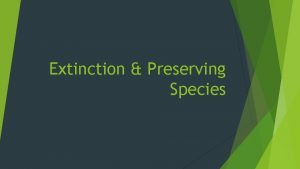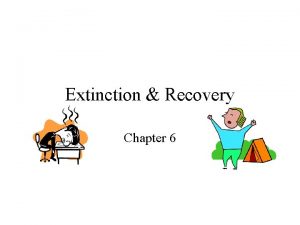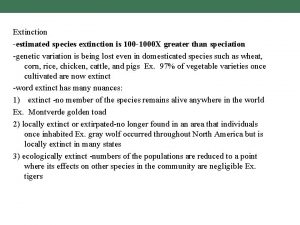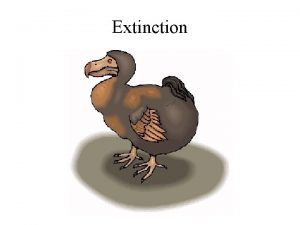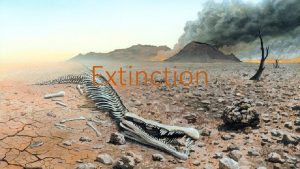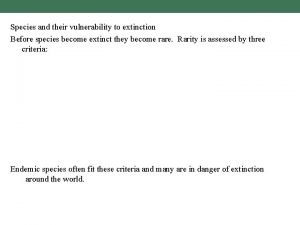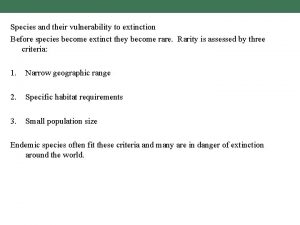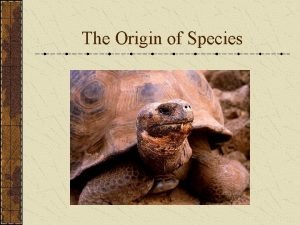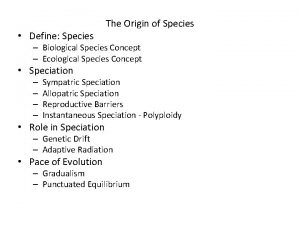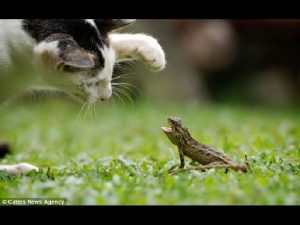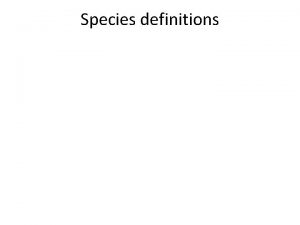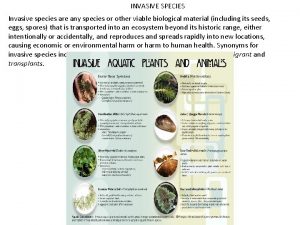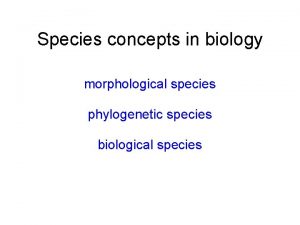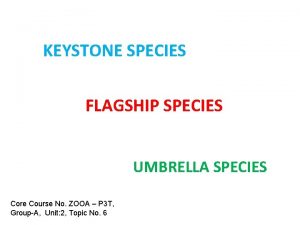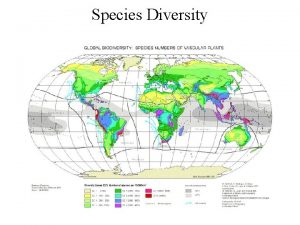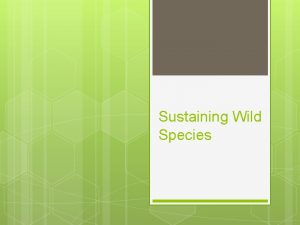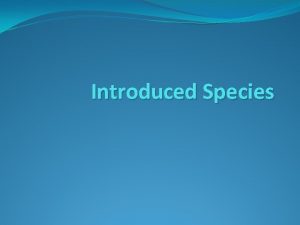Extinction All Species 99 9999 Extinction of all





























- Slides: 29

Extinction

All Species � 99. 9999% � Extinction of all species that have ever lived are extinct has always been a major force in macroevolution. � Species do not last forever…the mean expected lifespan of a marine bivalve is about 14 million years, and the mean expected lifespan of a terrestrial mammal might is about a tenth that. � Climate change, natural disasters, and other phenomena have always caused extinction. � As some species originate, they inevitably drive other species extinct. � Extinctions, in turn, pave the way for speciation. � An adaptive radiation is a wave of speciation that occurs as a new habitat is colonized by a lineage, or in the wake of the extinciton of another lineage. � An adaptive radiation of mammals followed the extinction of the dinosaurs.

Background Extinction � At all times in history, groups of organisms have a “background extinction rate”…species go extinct because of normal ecological or evolutionary processes, and as they disappear, other species take their places. ◦ For instance, on oceanic islands, the arrival of a predator, such as a monitor lizard or a snake, might precipitate the extinction of ground-nesting birds. Any such birds that are endemic to the island (that is, they live nowhere else) are gone for good. ◦ But oceanic islands come and go, as geological forces shape the Earth’s crust, and such extinctions are considered to be “normal”.

Mass Extinctions The history of life on Earth has been punctuated by a series of mass-extinctions. Extinction rates are much higher than background rates for a short period of time. Some are better understood than others, but they have profoundly influenced the evolution of life on Earth. Over the last 500 million years, there have been several major mass extinctions (not counting the current one): here are some big ones ○ ○ ○ 1) 2) 3) 4) 5) The Late Devonian Mid-Ordovician Permian-Triassic Late Triassic Cretaceous-Tertiary.


The Human Mass. Extinction � Since the development of agriculture, 10, 000 years ago, humans have modified an increasing proportion of the Earth’s resources for our own purposes. � Humans impact has caused extinction rates to be 10 to 1000 times greater than any time in the last 100, 000 years. � For example-one estimate for the recent background extinction rate for birds is one species extinction per 400 years. ◦ If only this natural rate of loss affected the number of bird species, no more than a couple of extinctions should have occurred in the past 800 years. � We have set in motion a mass extinction, one of the largest, that will not culminate until thousands of years from now.

The Human Mass. Extinction Humans have extensively modified the biosphere The human population passed 7 billion in the year 2011, and is growing at a rate of almost 3% per year. ○ Each human uses so much energy and so many resources that our activities influence virtually every aspect of the biosphere. In temperate areas, nearly all the land area that is suitable for agriculture is plowed or fenced. Worldwide, more than 35% of all land area is used for farms or permanent pastures. Much of the rest is grazed or logged on a regular basis.

The Human Mass. Extinction From 35 -45% of Global Net Primary Productivity now goes to serve human needs. In aquatic ecosystems as well, an increasing amount of productivity is harvested by humans. Nearly every major fishery in the Northern Hemisphere has showed strain from overharvesting, and many have collapsed.

Anthropogenic Extinction � Habitat destruction and habitat fragmentation � Habitat Change and Disruption of Ecosystem Processes � Introduction of Exotics � Overexploitation

Fragmented Habitats Essentially, every habitat fragment becomes a biological "island" (analogous to continental shelf islands, rather than the oceanic kind). As in the Mac Arthur Wilson model, the smaller the island, the smaller the population of any given species it can support. Small populations are at much greater risk of extinction due to random events, such as weather, disasters, and natural fluctuations in their population and sex ratio.

Here is a fragment seen from the air

Fragmented Habitats � Additionally, smaller populations support less genetic variation, which could lead to the fixation of harmful alleles and the ultimate extinction of the population (for very small fragments), or simply inhibit their ability to evolve in response to changing conditions

Fragmented Habitats frequently Lack Critical Ecosystem Processes Edge effects fundamentally alter habitat. For certain species, this can be critical to their ability to survive. For instance, places where human habitation borders nature preserves frequently have weedy plants, fire is controlled, domestic cats and dogs escape and prey on native wildlife, and human noise and activity disturb the behavior of certain animals.

Habitat Change and Disruption of Ecosystem Processes �Surviving areas of natural habitat often change because humans have fundamentally altered natural ecosystem processes.

Examples �Ladys' Slipper Orchids. There are probably about 25, 000 species of orchids worldwide, and they are being lost faster than they can be classified. �Orchids are typically tightly coevolved in mutualistic relationships with other species, and the loss of any of these relationships can lead to extinction. �Ladys' slippers are a very diverse group that occupy a wide variety of habitats in the Northern Hemisphere. They are in decline even in protected areas, such as Indiana Dunes.

Pacific Salmon are very important ecologically and economically off the West Coast of North America. Salmon species have experienced dramatic declines over the past few decades due to a variety of factors, many of which result from human habitat modification. Hydroelectric dams have resulted in increased juvenile mortality and made many habitats inaccessible to migrating salmon. Additionally, human logging and agriculture has silted and modified many of their upstream habitats, causing a drop in recruitment.

Introduction of Exotics � Human activities are creating the worldwide equivalent of the "Great American Faunal Interchange". This is an uncontrolled experiment in community ecology, with the potential result of a massive loss of gamma diversity worldwide caused by the loss of endemic species.

Zebra Mussels In 1998, the zebra mussel was discovered in Lake St. Claire near Detroit. It was introduced to the Great Lakes from the Caspian Sea, probably in the ballast water from a cargo ship, sometime around 1985. This mode of dispersal is very common, in 1982 the comb jelly (a ctenophore) was introduced to the Black Sea in a similar manner. Comb jellies increased in number until they amounted to an estimated 90% of animal biomass in the Caspian.

Honey Bees �Honey bees are native to Europe and Asia. Apis mellifera, is a European species that is widely cultivated for honey, beeswax, and as a pollinator. European immigrants probably introduced the honeybee to North America in the nineteenth century (Native Americans called it "white man's fly". ) It is a very effective competitor, and displaces native bee species.

Honey Bees �Recently, honeybees themselves have taken a hit, when the varolla mite was introduced in the 1980's. The overuse of insecticides, and widespread destruction of habitat, have decimated North American bee populations, both native and non-native.

Garlic Mustard, Purple Loostrife, Multiflora Rose �These are three more cases of an introduced species being too good at what they do. All three plants were introduced intentionally in the nineteenth century. Each of the three has become so common that it is likely to displace other species. For example, in some East Coast marshes, purple loosestrife amounts to 90% of the vegetation, displacing native sedges and other plants.

Overexpolitation Stellar's Sea Cow-this huge sirenian mammal lived in the reached a length of 26 feet and could way seven thousand pounds or more. It existed on a diet of kelp, and could not dive or swim quickly. It was delicious, and was hunted to extinction by sailors within 30 years of its discovery

What Makes A Species Vulnerable to extinction? � Endemism � Rarity � Small Population Size � Ecological Specialization � Beauty/Usefulness to humans/Competitor with Humans

� Endemism- Species that are restricted to a particular, small area, are more vulnerable to extinction

Rarity-Rarity is not the same thing as endeminsm, endemics can be very common in the restricted area where they do occur. "Naturally rare" species have low population densities, but may be widely distributed and have respectable population sizes. We do not completely understand the ecological factors that make some species "naturally rare", but when a common species gradually becomes rare, it is often a prelude to extinction. "Naturally rare" species can be a challenge to conservation, because they are difficult to monitor and it is very difficult to ensure that sufficient habitat is set aside for them.

Small Population Size-Small population sizes render a species very vulnerable to extinction, through reduced genetic variation via genetic drift, the potential for inbreeding depression, demographic stochasticity caused by random ecological disasters and, for sexual species, the small chance that every individual in the population might be born the same sex.

� Ecological Specialization-Ecological specialists are more prone to extinction because there are only a few ways they can 'fit themselves into" an ecosystem. They must have certain interspecific relationships in order to feed, obtain mates, have places to live, or maintain competitive superiority. The loss of other species in the community, or habitat change due to human activity, can change these factors, and render a formerly successful species vulnerable to extinction.

Useful to Humans or A Competitor of Humans have a way of killing all the pretty things, harvesting all the useful things, and hunting to extinction everything that could be perceived as a competitor. For instance, fishermen in San Francisco are prone to despising the California Sea Otter, despite its important place in the ecosystem of the California Coast, because of its status as a competitor. They are protected now, however, they were nearly hunted to extinction for their pelts. Species that cross the paths of humans sometimes suffer for it.

The Future of Our Own Species ◦ It is one of the strange ironies of our existence that, though the actions of our species modify the biosphere to an extent unprecedented in the history of the earth, as individuals, we do not necessarily feel any collective responsibility for our actions. ◦ The future of our own species will depend, to a very large extent, upon decisions we make as individuals, regarding our priorities. It is quite possible for our species to survive for many thousands of years more, but this is likely only if this generation takes additional steps to ensure that the planet will remain habitable to our own species.
 Background extinction vs mass extinction
Background extinction vs mass extinction Diskrit adalah
Diskrit adalah Serveur:9999
Serveur:9999 9999 em algarismo romano
9999 em algarismo romano Keystone species in desert
Keystone species in desert About 41 percent of all fish species inhabit
About 41 percent of all fish species inhabit Name a point that is collinear with the given points
Name a point that is collinear with the given points Extirpation vs extinction
Extirpation vs extinction Simultaneous extinction
Simultaneous extinction Extinction board
Extinction board Basal section mineral
Basal section mineral Extinction effects have not been documented clearly in
Extinction effects have not been documented clearly in Quaternary extinction
Quaternary extinction Permian extinction
Permian extinction Ap psychology behaviorism
Ap psychology behaviorism The sixth extinction chapter 3 summary
The sixth extinction chapter 3 summary Extinction clip art
Extinction clip art Pree psychology
Pree psychology Adityo kristianto
Adityo kristianto Ewald oseen extinction theorem
Ewald oseen extinction theorem Parallel extinction
Parallel extinction Types of extinction
Types of extinction Five conditions for hardy weinberg
Five conditions for hardy weinberg Permian extinction
Permian extinction Hyla
Hyla True colors of minerals
True colors of minerals Fish 395 m.y.a
Fish 395 m.y.a Apes chapter 9 sustaining biodiversity
Apes chapter 9 sustaining biodiversity Extinction aba definition
Extinction aba definition Current background extinction rate
Current background extinction rate

